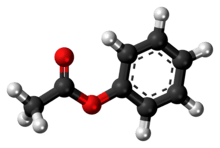Phenyl acetate
 | |
 | |
| Names | |
|---|---|
| Preferred IUPAC name
Phenyl acetate | |
| Systematic IUPAC name
Phenyl ethanoate | |
| Other names
Phenol acetate (Acetyloxy)benzene Acetoxybenzene | |
| Identifiers | |
3D model (JSmol) |
|
| ChEBI | |
| ChemSpider | |
| ECHA InfoCard | 100.004.160 |
PubChem CID |
|
| |
| |
| Properties | |
| C8H8O2 | |
| Molar mass | 136.15 g·mol−1 |
| Density | 1.075 g/mL[1] |
| Melting point | −30 °C (−22 °F; 243 K) |
| Boiling point | 195–196 °C (383–385 °F; 468–469 K)[1] |
| -82.04·10−6 cm3/mol | |
| Hazards | |
| Flash point | 76 °C (169 °F; 349 K)[1] |
Except where otherwise noted, data are given for materials in their standard state (at 25 °C [77 °F], 100 kPa). | |
| Infobox references | |
Phenyl acetate is the ester of phenol and acetyl chloride. One way that it can be produced by decarboxylation of aspirin. Another way that it can be produced is by reacting phenol with acetic anhydride.
Phenyl acetate can be separated into phenol and an acetate salt, via saponification: heating the phenyl acetate with a strong base, such as sodium hydroxide, will produce phenol and sodium acetate. The two chemicals can then be separated by heat and calcination of carbon or heat and filtration.
References
- 1 2 3 Phenyl acetate, Alfa Aesar
This article is issued from
Wikipedia.
The text is licensed under Creative Commons - Attribution - Sharealike.
Additional terms may apply for the media files.